- Retour accueil
- Vous êtes ici : Blog The Pyramids of the Cold v2 The Pyramids of the Cold • The Legend of Khufu and the 'magician' polymath Imhotep
The Pyramids of the Cold • The Legend of Khufu and the 'magician' polymath Imhotep
Publié par Bruno Coursol dans The Pyramids of the Cold v2 le 19/02/2024 à 18:13

The Legend of Khufu and the Magician is the key to understand the real mastermind behind the Great Pyramid of Giza and its operation: the super-scientist and physician polymath Imhotep, the one who performed some kind of “magical” and “miraculous” act for king Khufu. That is precisely because of this act that Imhotep became a thousand years later a “demi-god” worshiped all over ancient Egypt. But don’t be a fool here, there is no “magic” : all the extraordinary scientific and technological prowesses realized for the pharaohs and in particular the creation of evaporative cold from pressurized water in the Great Pyramid, only looked like “magic” at this time of the Bronze Age. In short: Magic, just like Imhotep himself is only about Science.
If it is stated by egyptologists that “Khufu was highly impressed with the mastery of Egyptian magic displayed by Imhotep, but unfortunately, we do not know anything about this miracle”, we know now because of The Pyramids of the Cold, that this last part of the statement is no longer true: we do know what really was Imhotep’s role regarding Khufu; it is him who designed the Great Pyramid for the evaporative cold production.
"Little Man's getting nervous" while playing Mastermind game, photograph by Bryan Laird, USA: https://boardgamegeek.com/image/1478520/mastermind
The Pyramids of the Cold v2 (May 2023-February 2024) • The Magicians behind the Great Pyramid
Section 45 • The legend of Khufu and the super-scientist "magician" and physician polymath that was Imhotep
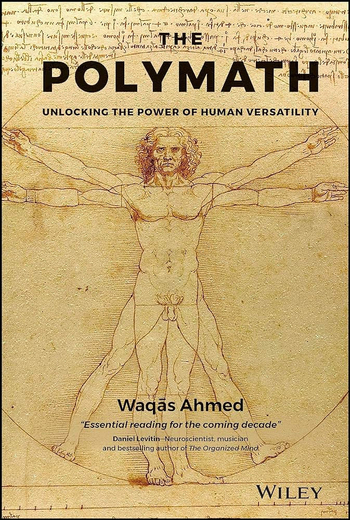
In Summary: in this new Section of the Pyramids of the Cold, I’ve decided to stop slowly reconstructing the operational layout of the Great Pyramid and the deciphering of the metaphors of the ancient Egyptian and the Jewish religions; instead I wanted to do a more “conventional” work, at least in the way that egyptologists would do themselves by focusing on “historical” data.
I first want to emphasize one more time the unique approach of the Pyramids of the Cold: I only approached the Great Pyramid’s deciphering without absolutely no preconceived idea whatsoever; and at the same time I didn’t stop myself finding clues and answers in fields that egyptologists never want to consider: if you aren’t interested in physics, chemistry, biology, medicine and engineering, and if you aren’t enjoying playing with the deciphering of metaphors, I’m sorry to say that, but there is no chance you can understand anything about ancient Egypt.
And it is not like ancient Egyptians themselves didn’t point out exactly that idea, because among the very few non royal people ever to be deified were Imhotep and Amenhotep son of Hapu, two “super scientist” polymath engineers. Additionally to that, Imhotep was also an accomplished physician: he is the first known doctor of human history and the first to write a complete medical treaty with the same scientific attitude we’d have today.
Imhotep is actually the real architect of the Great Pyramid, he is not the one who directed the construction of the building, but he is the one who designed the entire operational layout of the Pyramid. We’ll see that he probably didn’t live long enough to see with his own eyes the result of his design, that he probably never witnessed the Pyramid “alive” and that he never heard the beating Heart of the Pyramid.
But the fact that Imhotep was more than a simple engineer, the fact that he also was a physician, explains all the anatomical and medical metaphors we’ve already seen so many times and it is the proof that ancient Egyptians didn’t left (most of the time) the kidneys of the deceased during the mummification process by error: they really knew the filtration function of the kidneys, and their “symbiotic” relation with the heart. Of course, the heart and the kidneys of the deceased weren’t really about these organs, but about their corresponding parts in the Great Pyramid: the inclined well which functioned exactly like a living heart, and the biosand filter which really was the “sarcophagus”.
And all that is the origin of the famous legend of Khufu and the Magician, where it is said that Imhotep performed for Khufu some kind of magical and miraculous performance.
Well, that magical and miraculous performance, simply is the evaporative cold, and we’ll see that this is also the reason why the second “super scientist” polymath Amenhotep son of Hapu was deified as well when working for Akhenaten and Nefertiti, because we’ve already seen the real explanation of the reason why Akhenaten was called “heretic”: by representing himself into god Shu (who is all about dry and warm air), and Nefertiti into goddess Tefnut (who is all about water in the form of droplets), their association resulted into the creation of the evaporative cold, where droplets of liquid water is forced into dry air.
To understand ancient Egypt, you absolutely need a “polymath attitude”: you simply cannot only interest yourself in one single field. You need all of them. But what we’re talking about here isn’t “rocket science”; it is actually very common knowledge for someone living in the 21st century: you only need basic knowledge, like basic anatomy and physiology (the metaphors about the Heart of the Great Pyramid and the water of the inclined well “turning” into blood, or the fact that kidneys are the filtration organs of the human body), or basic knowledge in some Low Technology (like evaporative cold by flash evaporation, or the operation of a biosand filter), or basic chemistry principles like the counterflow exchanges between hot gases and brines (the Disc of Sabu)…
In short, if Imhotep has been deified, it is only because he his the one who designed the operation of the Great Pyramid, and most probably also because he was the one who glorified it by inventing all, or most of the myths, gods and goddesses who only served as propaganda tools; and if Imhotep used all the knowledge of his time, in all fields, we have to use the exact same tools; and we don’t even have to be geniuses for that: they are very simple tools, but there are many of them and sometimes you have to use some of them at the same time.
Imhotep was a Polymath, an ancient one, he looked at everything around him with the eyes of curiosity, critical and analytical spirit, and to understand ancient Egypt we need to do the same.
In short, in order to decipher ancient Egypt, you need to adopt a polymath approach only because it is a polymath who designed the whole thing. As Duke Leto Atreides would say: "Without change something sleeps inside us, and seldom awakens. The sleeper must awaken.” Franck Herbert, Dune.
The Polymath: “Unlocking the Power of Human Versatility” by Waqas Ahmed: https://en.wikipedia.org/wiki/The_Polymath
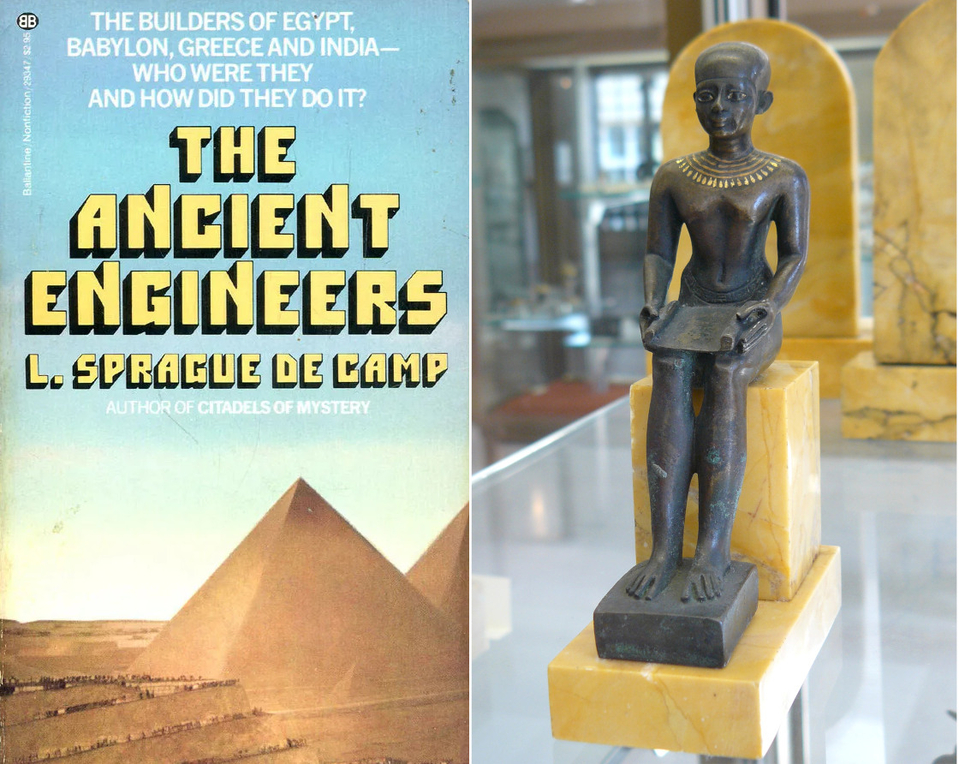
Figure of Imhotep at the Cabinet des médailles, ancienne collection Caylus, puis Louis XV - n° Inventaire 65-5646. « Statuette en bronze à incrustation d'or: Imhotep - Égypte entre le Ve et le Ier siècle av. J.C ». Photograph by Siren-Com: https://commons.wikimedia.org/wiki/File:Imhotep_collection_Caylus_C_des_M.jpg
L. Sprague de Camp cover : https://en.wikipedia.org/wiki/The_Ancient_Engineers
45.01 The ancient Egyptian super-scientist and physician polymath engineer Imhotep
“Imhotep (Greek name, Imouthes, c. 2667-2600 BCE) was an Egyptian polymath (a person expert in many areas of learning) best known as the architect of King Djoser's Step Pyramid at Saqqara. His name means "He Who Comes in Peace" and he is the only Egyptian besides Amenhotep to be fully deified. In time, he became the god of wisdom and medicine (or, according to some sources, god of science, medicine, and architecture). Imhotep was a priest, vizier to King Djoser (and possibly to the succeeding three kings of the Third Dynasty), a poet, physician, mathematician, astronomer, and architect. […] Although his Step Pyramid is considered his greatest achievement, he was also remembered for his medical treatises which regarded disease and injury as naturally occurring instead of punishments sent by gods or inflicted by spirits or curses”.” When Djoser died, he was placed in the burial chamber beneath the Step Pyramid and Imhotep is thought to have gone on to serve his successors, Sekhemkhet (c. 2650 BCE), Khaba (c. 2640 BCE), and Huni (c. 2630-2613 BCE). Scholars disagree on whether Imhotep served all four kings of the Third Dynasty but evidence suggests he lived a long life and was much sought after for his talents.” https://www.worldhistory.org/imhotep/
“Medical Contributions: Imhotep was practicing medicine and writing on the subject 2,200 years before Hippocrates, the Father of Modern Medicine, was born. He is generally considered the author of the Edwin Smith Papyrus, an Egyptian medical text, which contains almost 100 anatomical terms and describes 48 injuries and their treatment.” https://www.worldhistory.org/imhotep/
“Regarding the religious aspect, it is a fact that Imhotep had important functions. He reformed to bring the cult of Osiris into the Egyptian pantheon. After his death, Imhotep will be the subject of an important cult during the New Kingdom. It was a period during which the Egyptians turned to the important personages of the ancient empire to magnify them, and for some to deify them. This was the case for Pharaoh Khufu, but also for Imhotep who was associated with God Thoth (represented with an ibis head). His cult was alive and there were even temples dedicated to Imhotep (especially that of Philae, the best known).” https://www.wonders-of-the-world.net/Pyramids-of-Egypt/Imhotep.php
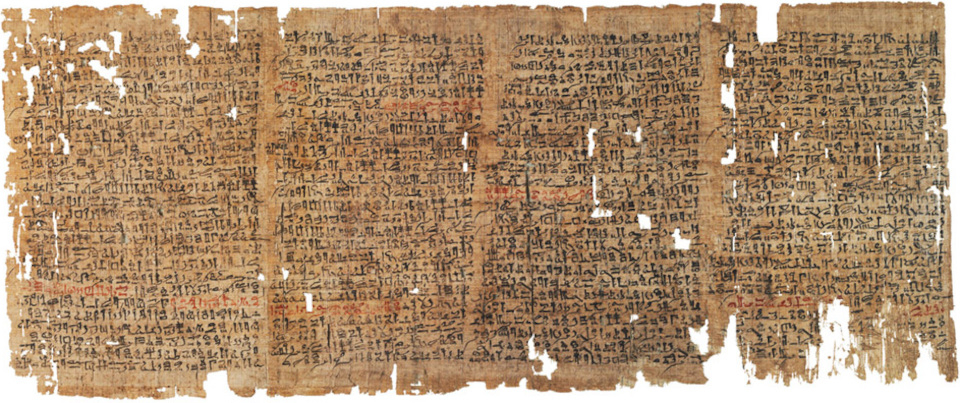
Merged photos depicting a copy of the Ancient Egyptian papyrus commonly known as "The Westcar Papyrus", sometimes also known by the longer name "Three Tales of Wonder from the Court of King Khufu", written in hieratic text and containing the legend of Khufu and the Magician, starring Imhotep. Original photo(s) taken by Keith Schengili-Roberts at the Altes Museum, Berlin. https://rhbarnhart.net/Westcar_trans_web.html
45.02 The tale of "how the royal architect Imhotep performed some kind of miracle" for king Khufu
“The tale of Khufu and the Magician from the Westcar Papyrus is full of ancient history, magic, prophecies, and the performance of miracles, making it a fascinating introduction to Egyptian literature.
But it was not until the Middle Kingdom that a true ‘literature’ was born in ancient Egypt. A series of genres developed, including prophetic texts, laments, discourses, apocalyptic texts, negative confessions, and of course narratives about historical events and characters. This is the case of the text that is written on the Westcar Papyrus, an artifact from the 13th dynasty, which tells stories that supposedly happened during the 4th dynasty, a millennium or so before that time. The main characters were kings Khufu, Sahure, and Neferirkare, and the royal architect Imhotep.”
“Although in the few remaining parts that can be read (the papyrus is heavily damaged at the beginning and the end), his name is not mentioned, Imhotep is with all probability the main character in the first story. The story is told from the perspective of one of Khufu’s sons, probably Djedefre, and seems to tell the tale of how the royal architect Imhotep performed some kind of miracle for the king. The text then proceeds to describe in all detail the quantity and type of offerings king Khufu made for another king, Djoser, and for Imhotep. It is stated that Khufu was highly impressed with the mastery of Egyptian magic or Heka displayed by Imhotep, but unfortunately, we do not know anything about this miracle.” https://www.thecollector.com/khufu-magician-egyptian-tale/
“In this papyrus Khufu is alleged to be seeking ancient knowledge to apply to the construction of his tomb (the Great Pyramid of Giza). Mackenzie translates the relevant phrase as the secrets of the dwelling of the god Thoth (1907:147) while Blackman translates the phrase as “the number of chambers in the sanctuary of Thoth” (Neederof 2008:37). Hornung confirms that there is considerable doubt as to the nature of the information he seeks” https://ancientegyptonline.co.uk/khufumag/

Science is magic (and of course, magic is science)... Science Magic kits for over 8-year-old children, by 4M: https://www.4mtoys.com.au/products/4m-kidzlabs-science-magic
and Science 4 You: https://www.science4youtoys.com/us/the-science-of-magic/773
45.03 Even 8-year-old kids know Science is Magic... maybe grown-ups should know and remember it too
What is “incredible” to me, even if absolutely not surprising, is the fact that egyptologists are so eager to see Imhotep as a “magician” without ever questioning the whole thing. Because if there is something certain about Imhotep, is that he really is the exact opposite of “magic”.
You only use the term “magic” when there is something you witness but you don’t understand, and when you are a polymath like Imhotep, “magic” is simply not an option: when there is something you don’t understand, you just want to study it until understanding comes to you.
This is what a polymath is all about: studying as many different fields as necessary until understanding. And this is what Imhotep was all about. So when Imhotep is supposed to have achieved some kind of “magical” trick for Khufu, what you know for sure is that there is no magic involved in any way.
“A polymath (Greek: πολυμαθής, romanized: polymathēs, lit. 'having learned much'; Latin: homo universalis, lit. 'universal human') is an individual whose knowledge spans a substantial number of subjects, known to draw on complex bodies of knowledge to solve specific problems. In Western Europe, the first work to use the term polymathy in its title (De Polymathia tractatio: integri operis de studiis veterum) was published in 1603 by Johann von Wowern, a Hamburg philosopher. Von Wowern defined polymathy as "knowledge of various matters, drawn from all kinds of studies ... ranging freely through all the fields of the disciplines, as far as the human mind, with unwearied industry, is able to pursue them". […] Polymaths include the great scholars and thinkers of the Renaissance and Enlightenment, who excelled at several fields in science, technology, engineering, mathematics, and the arts. In the Italian Renaissance, the idea of the polymath was allegedly expressed by Leon Battista Alberti (1404–1472), a polymath himself, in the statement that "a man can do all things if he will". Gottfried Wilhelm Leibniz has often been seen as a polymath. Al-Biruni was also a polymath. Other well-known and celebrated polymaths include Leonardo da Vinci…” https://en.wikipedia.org/wiki/Polymath
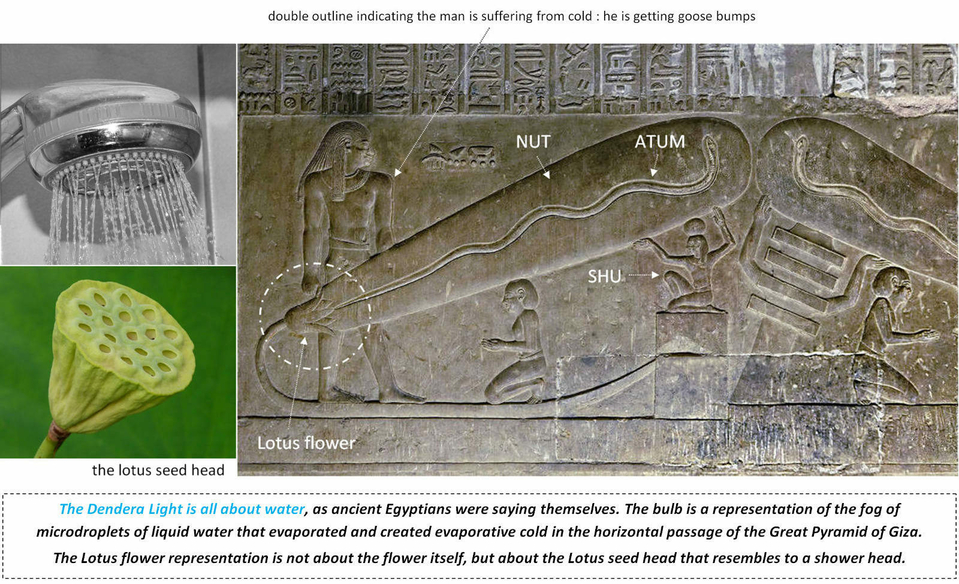
The Dendera Light is a stone relief in the Hathor temple at Denderah in Egypt, that depict Harsomtus, in the form of a snake, emerging from a lotus flower. "In six reliefs he is shown within an oval container called hn, which might represent the womb of Nut. These superficially resemble a lamp or light." Photograph thanks to Kairoinfo4U and posted on flickr: https://www.flickr.com/photos/manna4u/14525094039/in/photostream/
Lotus seed head thanks to Dinkum: commons.wikimedia.org/wiki/File:Nelumbo_nucifera_%28fruit%29.JPG
45.04 The "magical energy in liquid form" Dendera Light really is the evaporative cooling fog of microdroplets...
One of the best example of the metaphoric use of “magic” to describe some mysterious and miraculous aspect of physics, is about the famous Dendera Light: most of the time, ancient Egyptians are all about metaphors, but here they really drew the very shape of the fog of microdroplets that was created in the evaporative cooling passage and they described it as a “magical energy in liquid form”.
[About the snake inside the Dendera Light Bulb]: "The field surrounding Ra’s snake form is referred to in ancient Egyptian literature as protective magical energy in liquid form that all gods and pharaohs possess (Faulkner 1970*)." https://ahotcupofjoe.net/2016/11/dendera-light-bulb-and-bagdad-battery-nonsense/
*I'm not sure, but the excerpt might be from "The ancient Egyptian book of the dead / translated by Raymond O. Faulkner ; edited by Carol Andrews, 1972."
More about the Dendera Light: Section 2
45.05 ... and Imhotep was indeed involved with the cold since the very beginning of his work with king Djoser: his Step Pyramid was indeed officially called “the Refreshment of the Gods”
If you’ve read the other Sections of the Pyramids of the Cold, you know that my assumption is that the cold created in the Great Pyramid by flash evaporation, and stored in the Queen’s chamber (the only chamber that passes through the central axis of the Pyramid, only because of a thermal insulation reason), would have been because of the need to cool down the chemical reactions involved in a Solvay-like process for sodium carbonate production (also called natron, the salt used in the mummification process).
The goal would have been to chemically, hence “magically” create 100% pure natron instead of mining an impure product from the ground.
It looks like chemistry was since the very beginning of the pharaoh’s era, the real deal which supported all the legitimacy of the pharaohs, and that they were fighting for a very long time with overheating of whatever chemical reactions they were trying to master.
It also looks like Imhotep was since the very beginning of his work, involved in the attempt to cool down these reactions, as it is perfectly known that the Step Pyramid was officially called “the Refreshment of the Gods”.
“Imhotep is most famous as the builder of Djoser’s unprecedented step pyramid complex, called “The Refreshment of the Gods.” Imhotep designed this complex on a scale that surpassed everything achieved by his predecessors.“ https://arce.org/resource/search-imhotep-tomb-architect-turned-god-remains-mystery/
More on the Solvay process in Section 33 (the limestone kiln and the ammonia smell of the Red Pyramid) and Section 34 (the Disc of Sabu is a counterflow Solvay plate).
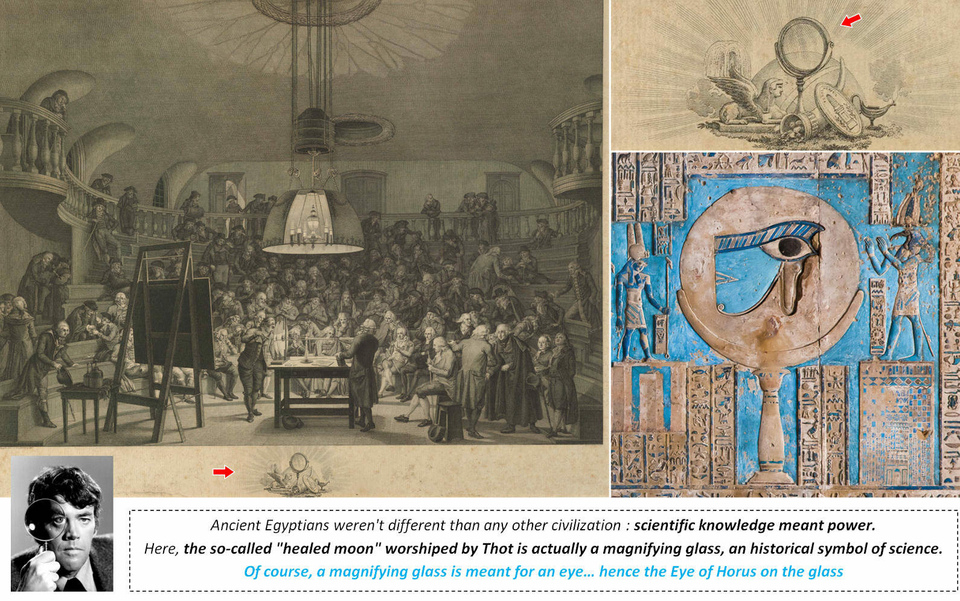
"The astronomical ceiling at the Pronaos, outer hypostyle hall in the Temple of Hathor in the Dendera Temple complex, near Dendera, Egypt: first Band west from the centre, showing the full healed moon on a pillar depicted as "Wadjet" the Eye of Horus healed by [the god of Science] Thoth, who is portrayed at the right." Photograph thanks to kairoinfo4u: https://www.flickr.com/photos/manna4u/9295311496
45.06 The deification of Science and the super-scientist engineer and physician Imhotep "through" a simple but iconic magnifying glass... and the hilarious “moon on a pillar” academical story
Everybody agrees on the fact that Imhotep has been the first scientist-physician-polymath in recorded history and that he also has been equated with Thoth, god of architecture, mathematics and medicine even though egyptologists seem very reluctant to use the technical term “engineer”. But what is very important is that at all times, the magnifying glass would have most certainly been the perfect illustration for the kind of scientist and physician that Imhotep was.
What is completely unbelievable for me about the representation of Thoth on the above Dendera Temple painting, is that people didn’t flinch an inch when being told by egyptologists that he is actually worshiping a full moon, resting on a crescent moon and standing on a pillar. Do people really believe ancient Egyptians were so dumb they would have painted such a stupid and meaningless thing?
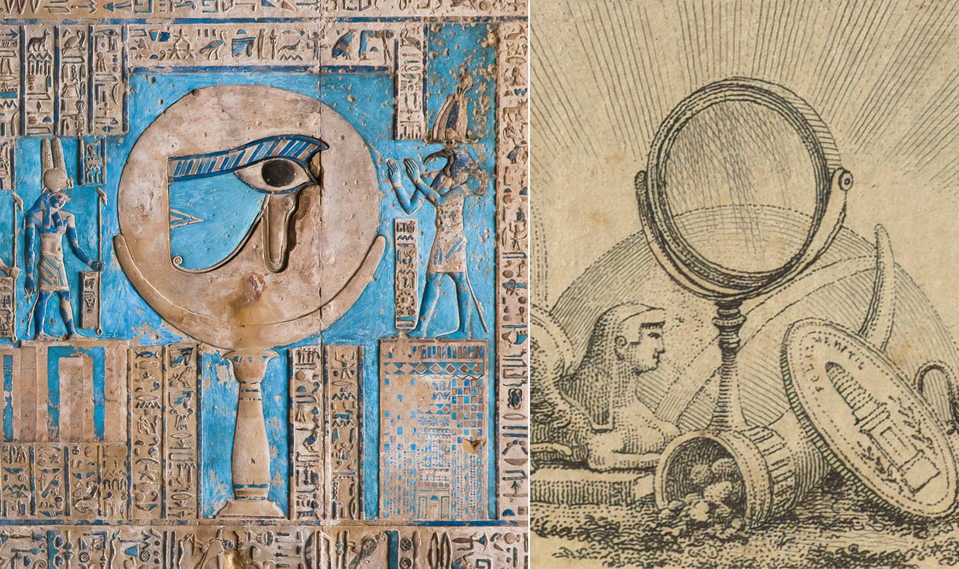
The ancient Egyptian god of Science Thoth (on the right part of the image), looking through a magnifying glass... or looking at the full moon, on top of a crescent moon, itself on top of a pillar... for some esoteric reason, I guess. Be sure that there is only one right answer here, but there is an extra clue: the Eye of Horus.
45.07 A magnifying glass is meant for an eye... hence the Eye of Horus on the glass

Knowing that Thoth is in short, the god of Science, how come nobody ever suggested he was simply standing in front of a magnifying glass with a beautiful gilded wooden stand that would have looked exactly like an antique magnifying glass from the 1800’s?
And how come nobody ever suggested that there was a representation of an Eye of Horus, precisely because a magnifying glass is only meant for an eye? And this isn’t just a rhetorical question here: I’m sincerely asking how come people could have been so inclined to accept being conditioned by the "cute" stories told by egyptologists. How come people are so eager to continue believing in stories coming right from the 1800’s, especially today when everything is seen so easily as fake news, whether they really are or not?
Why is nobody seriously challenging egyptologists for the magnifying glass, the reason of the massive salt deposits in the Queen’s chamber of the Great Pyramid, or the girdle stones, or the sand filter in the Step Pyramid that nobody wants to talk about?
“Imhotep "(the one who) comes in peace" was an Egyptian chancellor to the Pharaoh Djoser, possible architect of Djoser's step pyramid, and high priest of the sun god Ra at Heliopolis. Very little is known of Imhotep as a historical figure, but in the 3,000 years following his death, he was gradually glorified and deified. […] Two thousand years after his death, Imhotep's status had risen to that of a god of medicine and healing. Eventually, Imhotep was equated with Thoth, the god of architecture, mathematics, and medicine, and patron of scribes: Imhotep’s cult was merged with that of his own former tutelary god.” https://en.wikipedia.org/wiki/Imhotep
Jim Hutton as detective Ellery Queen, looking through a magnifying glass, courtesy of NBC Television: https://en.wikipedia.org/wiki/Magnifying_glass#/media/File:Jim_Hutton_Ellery_Queen_1976.JPG

45.08 The double meaning of the ancient Egyptian symbols
The Eye of Horus symbol is probably one of the most complicate ancient Egyptian symbols with many different layers of meaning. Among all of the symbols I’ve already tried to decipher, it certainly is one (with the Djed pillar) I’m the less satisfied with.
But what is interesting, is that sometimes ancient Egyptians used these symbols not for their original and complete meaning, but for just one tiny aspect of them; and here with the magnifying glass we’ve a perfect example of that trick: if the Eye of Horus is represented on the glass, it doesn’t have anything to do about Horus, but only about an eye.
They needed an eye looking through the magnifying glass, so they simply used the Eye of Horus because everybody already knew about this eye. In short, they've also used "religious" symbols as simple rebus.
Examples of Rebuses, by Jennifer Gunner, M.Ed. Education: yourdictionary.com/articles/examples-rebuses
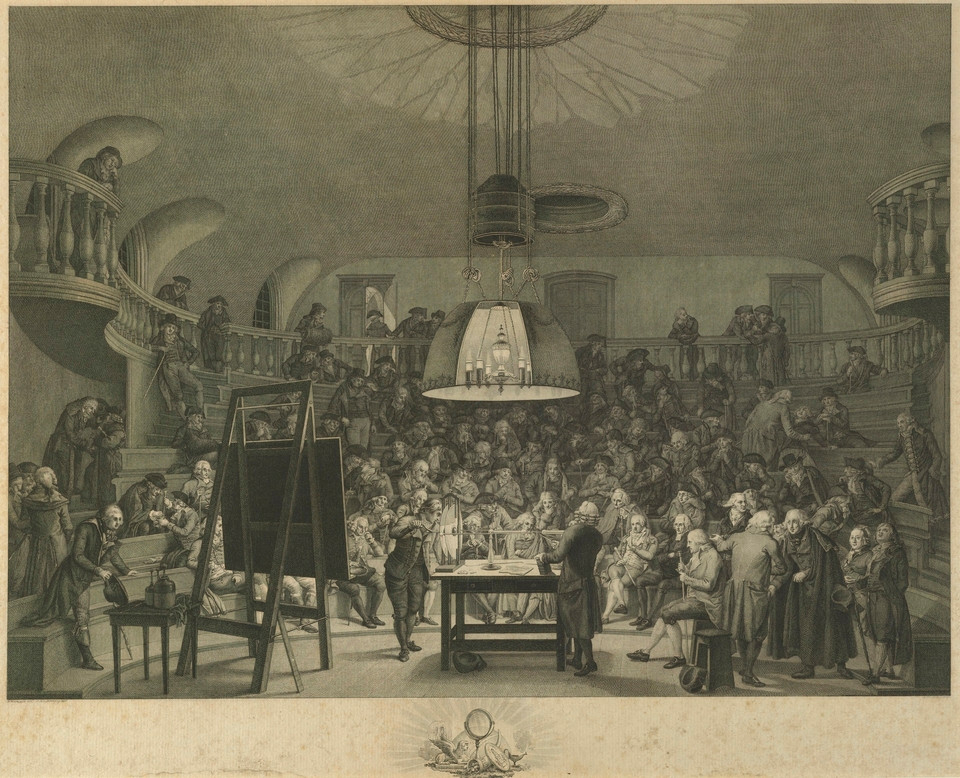
"This engraving shows Dutch mathematician and physicist Jean Henri van Swinden (1746–1823) demonstrating the generation of electricity to the Felix Meritis Society in Amsterdam. The Felix Meritis Society was founded in the late 18th century to promote the arts and sciences (Felix Meritis translates as "Happiness through Merit")". Barbiers, Pieter Pietersz., and Jacques Kuyper. Laid paper, 1800–1899. Science History Institute, Philadelphia U.S.A.: https://digital.sciencehistory.org/works/zg64tm573
45.09 Thoth and the magnifying glass are all about scientific demonstration and teaching
I've used this image many times, but what I want to point out here, is how good is the analogy between this perfect illustration of demonstrating science in the 1800s, compared to the illustration of Thoth in the Dendera "temple"; they are not just similar, they are exactly the same: Thoth is demonstrating his knowledge in science through the magnifying glass, and towards all the other gods assembled in front of him, just like Dutch mathematician and physicist Jean Henri van Swinden is demonstrating the generation of electricity to the Felix Meritis Society in Amsterdam.
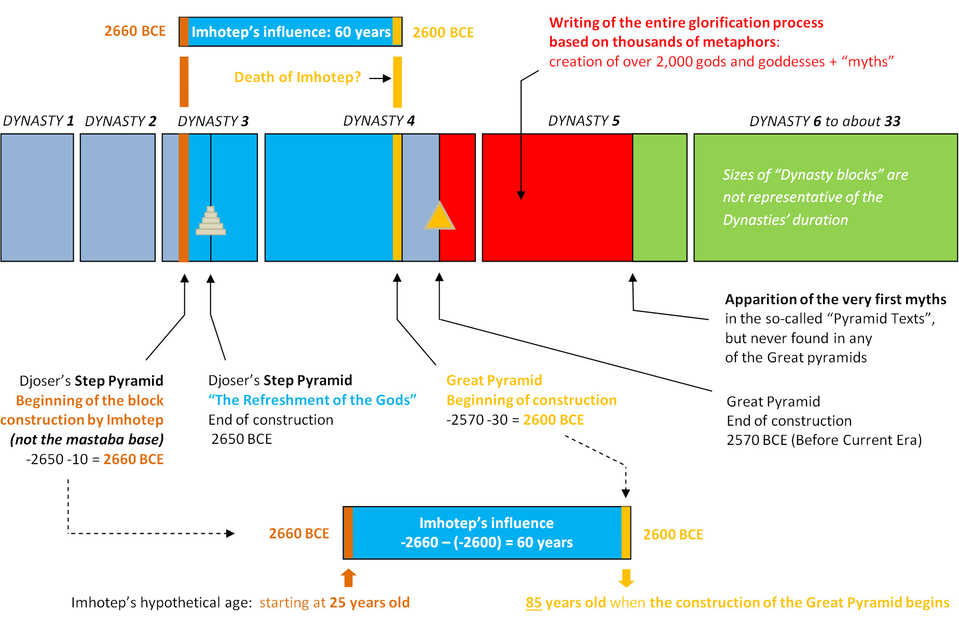
Time sequence leading to the construction of the Great Pyramid of Giza, entirely designed by Imhotep. “Imhotep is thought to have gone on to serve his successors, Sekhemkhet (c. 2650 BCE), Khaba (c. 2640 BCE), and Huni (c. 2630-2613 BCE). Scholars disagree on whether Imhotep served all four kings of the Third Dynasty but evidence suggests he lived a long life and was much sought after for his talents.” https://www.worldhistory.org/imhotep/
Data: https://en.wikipedia.org/wiki/Great_Pyramid_of_Giza and https://en.wikipedia.org/wiki/Pyramid_of_Djoser
45.10 Imhotep is the Mastermind behind the Great Pyramid: he didn’t built it but he designed it
The fact that the Legend of Khufu and the Magician is clearly associating Imhotep with Khufu and proclaiming that he performed some kind of magic and miraculous act is telling us that Imhotep really is the designer of the Great Pyramid: it is Imhotep who performed the evaporative cold production.
"The story is told from the perspective of one of Khufu’s sons, probably Djedefre, and seems to tell the tale of how the royal architect Imhotep performed some kind of miracle for the king. The text then proceeds to describe in all detail the quantity and type of offerings king Khufu made for another king, Djoser, and for Imhotep. It is stated that Khufu was highly impressed with the mastery of Egyptian magic or Heka displayed by Imhotep, but unfortunately, we do not know anything about this miracle.” https://www.thecollector.com/khufu-magician-egyptian-tale/
Now, the problem is to know the exact time sequence in which everything occurred and if Imhotep was still alive when the construction of the Great Pyramid started. In the above diagram, Imhotep is starting is engineering career with the Step Pyramid of pharaoh Djoser, and I arbitrarily supposed he only worked 10 years on this pyramid, only because Imhotep probably only added limestone blocks on the preexisting mastaba.
It is well known that Imhotep had a very long life and that he served many pharaohs. My understanding is that if Imhotep has been the engineer and architect of the Step Pyramid, he rapidly became the master engineer of many architects working for the pharaohs. But Imhotep being a polymath, he probably also had hundreds of scientists and physicians under his authority.
If dates officially known about the construction of the Step Pyramid and the Great Pyramid are correct, Imhotep would have been 85 years old when the construction of the Great Pyramid would have started and would have worked for pharaohs for 60 years. If you count 27 years of construction for the Great Pyramid, it becomes very unlikely Imhotep would have had the chance to see his pyramid in operation.
How heartbreaking it can be, Imhotep probably never heard the beating heart of his pyramid.
But there is also something that comes to mind: 85 years old seems so close to what could have been the age of Imhotep at his death, that we should probably consider the possibility that it precisely is Imhotep’s death that triggered the start of building the pyramid.
It would actually make perfect sense that Imhotep would have developed his design until the very end; whether the end was his death or a point where he couldn’t work any more.
Of course, this is only an hypothesis, and if Imhotep was still alive at the beginning of the construction of the Great Pyramid, he most certainly died during the 20 and something years of construction. We cannot be sure of when the Great Pyramid was operated for the very first time, because remember: when operational, the elevation wasn’t finished (hence the shafts of the Queen’s chamber ending inside the masonry, Section 31 “The water supply issue”).
It is even possible that Imhotep was long dead when the construction really began, and there could be many reasons that would explain many years of delay between when the final design was ready and the beginning of the construction. Maybe the following excerpt is supporting this idea:
“In this papyrus Khufu is alleged to be seeking ancient knowledge to apply to the construction of his tomb (the Great Pyramid of Giza). Mackenzie translates the relevant phrase as the secrets of the dwelling of the god Thoth (1907:147) while Blackman translates the phrase as “the number of chambers in the sanctuary of Thoth” (Neederof 2008:37). Hornung confirms that there is considerable doubt as to the nature of the information he seeks” https://ancientegyptonline.co.uk/khufumag/
“Unfortunately we have no traces of other constructions of which he is the author. But the little documentation that specialists have on this subject is so weak that Imhotep has no problem in constructing other buildings, but we do not know them today.” https://www.wonders-of-the-world.net/Pyramids-of-Egypt/Imhotep.php

Time sequence of the apparition of the first Egyptian myths in the “Pyramid Texts”, only starting near the end of the Fifth Dynasty, because they are all about the glorification of the operation of the Great Pyramid of Khufu. Same thing for the first Canopic jars which appeared in the tomb of Hetepheres, Khufu's mother. Only a very few individual deities were known before these Pyramid Texts, but only because the glorification process started right away, at the very beginning of the Scientific Era which gave birth to the first Dynasties.
“The first evidence of the worship of Osiris is from the middle of the Fifth Dynasty of Egypt (25th century BC), although it is likely that he was worshiped much earlier; the Khenti-Amentiu epithet dates to at least the First Dynasty, and was also used as a pharaonic title. Most information available on the Osiris myth is derived from allusions in the Pyramid Texts at the end of the Fifth Dynasty” https://en.wikipedia.org/wiki/Osiris
45.11 The first gods and goddesses existing before the Great Pyramid reinforce the idea that Science was used as a support to legitimate pharaohs as the rulers, since the very beginning of the pharaonic era
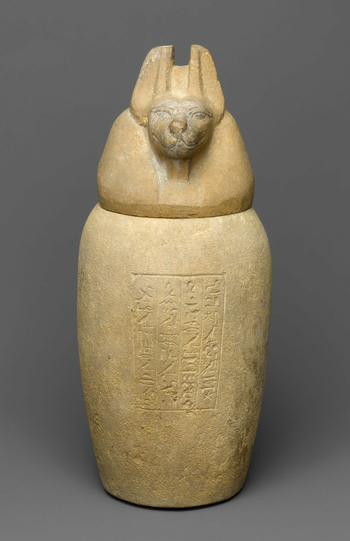
If the first ancient Egyptian myths only start to appear in the “Pyramids Texts” during the middle of the Fifth Dynasty, because of the incredible success and “deal breaker” that was the Great Pyramid, of course some (actually a very small number) of gods appeared long before that, but only because the Great Pyramid literally is the pinnacle of the whole scientific era that pharaohs engaged themselves into: surely what I called the hauling “Beetle”, ropes and part(s) of the impactor would have been used maybe since the very beginning. The fact that some gods like Horus, Ra or Osiris would have been the result of the glorification process, indicates that pharaohs really tried to use their scientific and technological knowledge in order to legitimate themselves as kings, the rulers of ancient Egypt.
“Many gods appear in artwork from the Early Dynastic Period of Egypt's history (c. 3100–2686 BC), but little about the gods' actions can be gleaned from these sources because they include minimal writing. The Egyptians began using writing more extensively in the Old Kingdom, in which appeared the first major source of Egyptian mythology: the Pyramid Texts.” https://en.wikipedia.org/wiki/Egyptian_mythology
“The Pyramid Texts are the oldest ancient Egyptian funerary texts, dating to the late Old Kingdom. They are the earliest known corpus of ancient Egyptian religious texts. Written in Old Egyptian, the pyramid texts were carved onto the subterranean walls and sarcophagi of pyramids at Saqqara from the end of the Fifth Dynasty, and throughout the Sixth Dynasty of the Old Kingdom, and into the Eighth Dynasty of the First Intermediate Period. The oldest of the texts have been dated to c. 2400–2300 BCE.” https://en.wikipedia.org/wiki/Pyramid_Texts
“Canopic jars first appeared in the tomb of Hetepheres, the mother of Khufu, builder of the Great Pyramid. They were intended to hold the separately mummified internal organs. Canopic jar with stopper in the form of Duamutef, the jackal-headed god”. The Brooklyn Museum: brooklynmuseum.org/opencollection/objects/4107
Deciphering of the Canopic Jars in Section 27 "The guide to the Afterlife"
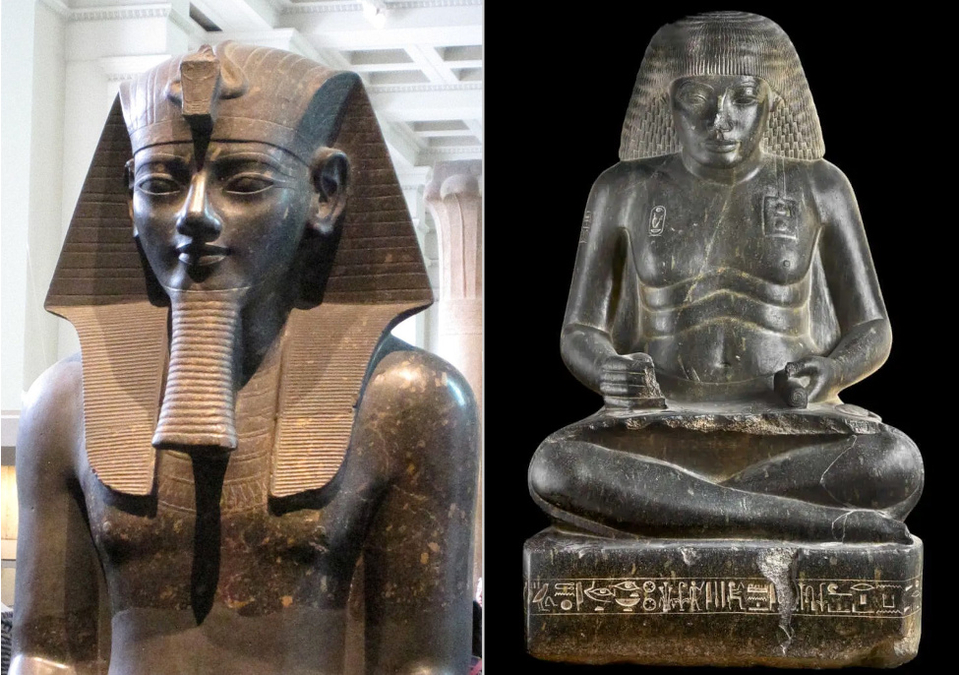
Colossal statue of Amenhotep III in the British Museum. Photograph by A. Parrot: https://en.wikipedia.org/wiki/Amenhotep_III#/media/File:Colossal_Amenhotep_III_British_Museum.jpg
Statue of Amenhotep Son of Hapu, who worked for Amenhotep III and his son Amenhotep IV "Akhenaten". Hurghada Museum. JE 44861: https://egypt-museum.com/statue-of-amenhotep-son-of-hapu/
45.12 Only two* non-royal persons have ever been deified: Imhotep and Amenhotep, son of Hapu
Now, it is getting very exiting; because if Imhotep has been deified about 2,000 years after his death, there is another polymath “architect” like him who has been deified, and it is Amenhotep Son of Hapu.
Two things here:
• Both Imhotep and Amenhotep Son of Hapu are believed to be the only non-royal persons who have ever been deified, and we know now that Imhotep was the one to have designed the entire layout of the Great Pyramid that created the cold from pressurized water and flash evaporation in non adiabatic conditions: the evaporation occurred in overpressure because of the air pushed by the impactor, resulting in a higher efficiency process (more air in the same space, means more water can be forced in that space, hence the cold can be even colder).
• When you look at who served Amenhotep Son of Hapu, this is where the excitement begins, because it was Amenhotep III, the father of Amenhotep IV and better known as Akhenaten.
I really hope, whoever is reading this, that you’ve already read Section 4 “The theorization of the evaporative cooling by Akhenaten and Nefertiti”, because this Section explains what really wanted to accomplished Akhenaten and why he has been called the “heretic pharaoh”.
In just a few words, when egyptologists are saying that Akhenaten only worshiped the Aten Sun, it is simply false: how can you say that when Akhenaten represented himself in god Shu and Nefertiti represented herself as goddess Tefnut? It simply doesn’t make any sense. But, of course there is an explanation for the three of them: the Aten Sun, Akhenaten and Nefertiti.
It turns out that when you study Shu, you realize that this god is actually all about dry and warm air; and that Tefnut is all about water in form of droplets (not the water of the river, nor the water of a pool or the sea, just the water in form of droplets). Of course, if you combine both Shu and Tefnut together, dry warm air with droplets of water, this is how you produce the evaporative cold.
In other words, what Akhenaten and Nefertiti wanted to realize is to associate themselves (their union as husband and wife) as creators of the cold. They aren’t worshiping the (light of the) Aten Sun: they are giving the Cold to the Heat of the Aten.
What Akhenaten and Nefertiti wanted to do is stop the worshiping of HOW was physically and experimentally produced evaporative cold in the Great Pyramid (no more reference to the impactor, nor the hauling Beetle, nothing), but instead they wanted them to be associated with the production of the Cold, by the mean of their physical Union as husband and wife.
* apparently more than two are known, since the beginning of the 21st century.
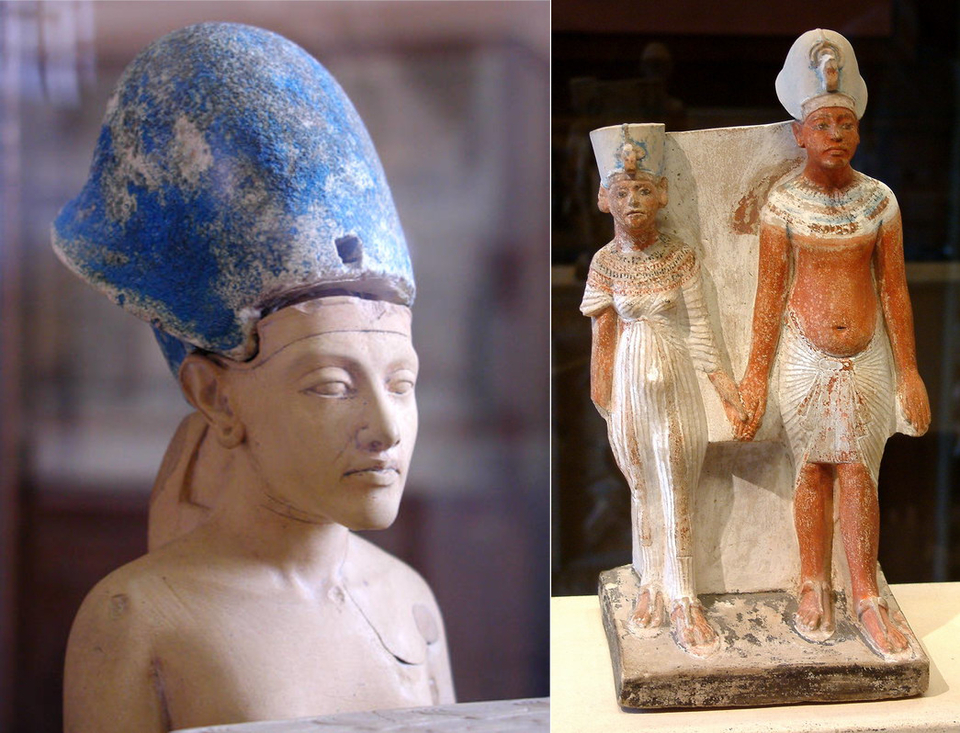
Akhenaten wearing the Blue Crown: https://en.wikipedia.org/wiki/Khepresh
Akhenaten and Nefertiti holding hands, both connected to each over and wearing the Blue Crown. Photograph by Guillaume Blanchard: https://en.wikipedia.org/wiki/Khepresh#/media/File:Egypte_louvre_173.jpg
“Two thousand years after his death, Imhotep's status had risen to that of a god of medicine and healing. Eventually, Imhotep was equated with Thoth, the god of architecture, mathematics, and medicine, and patron of scribes: Imhotep's cult was merged with that of his own former tutelary god. He was revered in the region of Thebes as the "brother" of Amenhotep, son of Hapu – another deified architect – in the temples dedicated to Thoth.” https://en.wikipedia.org/wiki/Imhotep
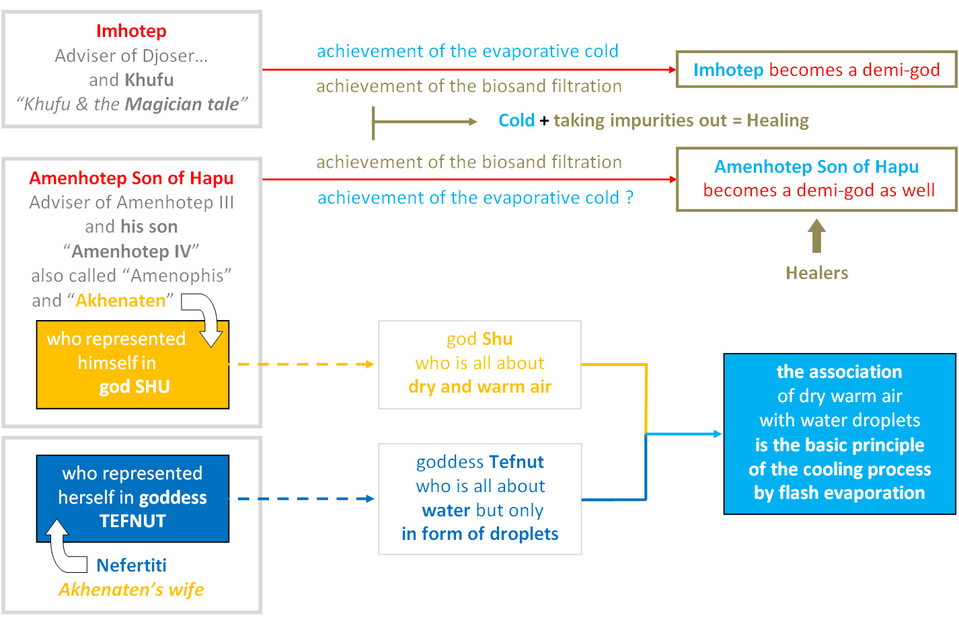
"The ancient Egyptian god Shu is represented as a human with feathers on his head, as he is associated with dry and warm air." [...] "Fog and clouds were also Shu's elements" https://en.wikipedia.org/wiki/Shu_(Egyptian_god)
"Shu is thus not only "air which is in the sun", but also, according to Akhenaton's religion, "heat which is in Aton". Egyptian Myths And Legend, By Donald Mackenzie.
"Tefnut (tfnwt) is a deity of moisture, moist air, dew and rain in Ancient Egyptian religion."
"Literally translating as "That Water", the name Tefnut has been linked to the verb 'tfn' meaning 'to spit' and versions of the creation myth say that Ra (or Atum) spat her out and her name was written as a mouth spitting in late texts." https://en.wikipedia.org/wiki/Tefnut
45.13 Somehow, it is the Polymath Amenhotep Son of Hapu who was responsible for the heretic religious changes made by Akhenaten and the abandonment of his original name Amenhotep IV
We know that it is Amenhotep Son of Hapu who occupied the position of “Polymath” when Amenhotep IV changed his name for Akhenaten and revolutionized the entire ancient Egyptian religion; and apparently nobody correlated this with the fact that Amenhotep Son of Hapu has been just like the very first polymath Imhotep, deified and worshiped.
What it means, is that of course, it is Amenhotep Son of Hapu himself who is responsible for all these changes in the religion practices and the change in name of Amenhotep IV for “Akhenaten”.
And we know that for sure because it is well known that Amenhotep Son of Hapu did indeed accomplished some kind of mysterious act for both Amenhotep III and IV, just like Imhotep had already accomplished some kind of magical and miraculous act for Khufu.
When it is mentioned the fact that both Amenhotep III and IV “Akhenaten” were "desirous to become a spectator of the gods”, it is because they wanted to see by themselves all or part of what had been done in the Great Pyramid.
This is the exact same pattern here between Amenhotep Son of Hapu and Amenhotep IV “Akhenaten”. The problem is “only” about what kind of scientific or technological demonstration had been accomplished.
“Manetho gives a legendary account of how Amenhotep advised a king named Amenophis, who was "desirous to become a spectator of the gods, as had Orus, one of his predecessors in that kingdom, desired the same before him". Although Manetho states that Amenophis was the son of Ramses and the father of Sethos (Seti) who was later named Ramses after the father of Amenophis, Amenophis is commonly identified with Akhenaton also known as Amenhotep IV, while Orus fits with the latter's father, Amenhotep III. Manetho relates that the wise man counseled that the king should "clear the whole country of the lepers and of the other impure people" and that the King then sent 80,000 lepers to the quarries. After this the wise man foresaw that the lepers would ally themselves with people coming to their help and subdue Egypt. He put the prophecy into letter to the King and then killed himself. Manetho associates this event with the Exodus of the Israelites from Egypt, but Josephus strongly rejects this interpretation.” https://en.wikipedia.org/wiki/Amenhotep,_son_of_Hapu
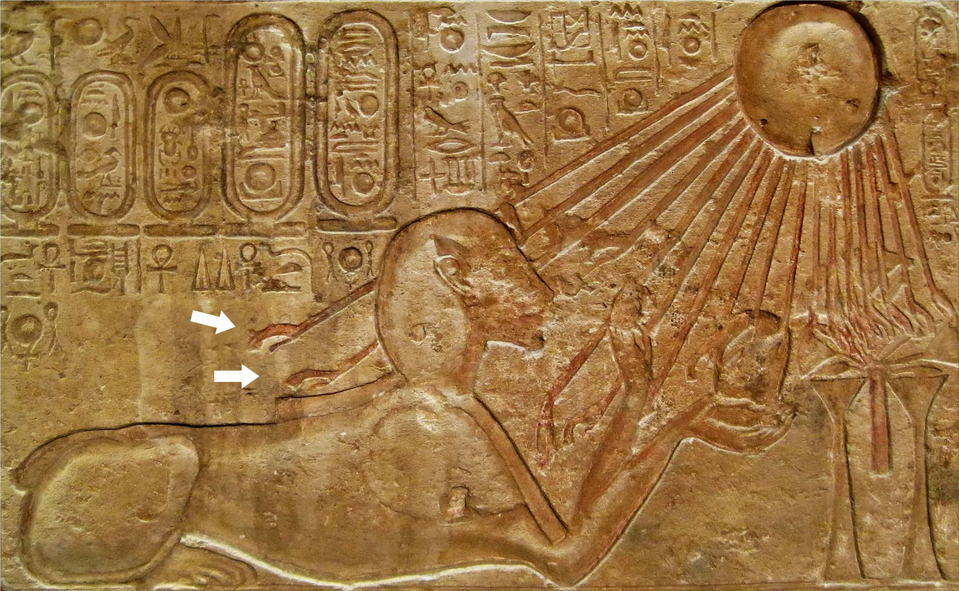
Akhenaten as a Sphinx. Kestner Museum, Hannover. Hans Ollermann: flickr.com/photos/menesje/15029671878
45.14 The Akhenaten sphinx basking in the Aten Sun: the beams are about the heat of the Sun, not the light
This image showing King Akhenaten in the form of a sphinx is maybe one of the best representations of the real meaning of the sun Aten.
It is said that Aten is radiating beams of light, but the position of the sphinx is telling us another story: he is depicted resting on the ground with the sun beams all around him, back included, and these beams have hands at their ends.
Hands are made for touching, so the solar beams are "touching" the sphinx but also all the scenery around him: they are not light beams but they are transmitting the heat radiating from the Solar disc Aten and they are "petting" the sphinx who is basking in the sun.

45.15 Lions aren’t basking in the sun because of its light, but because of its heat
“Lions Panthera leo spend many hours lounging in the sun, and there’s a reason: sunbathing significantly lowers their energy demands. That can be important, because hunting requires a lot of energy—and one lion may consume as much as 70 pounds of meat at one feeding to satisfy that need. Researchers in Namibia found that lions with empty bellies spend more time basking in the sun, and they are more likely to sunbathe with their sides or bellies exposed during the heat of the day. Lions with full stomachs tend to bask in direct sun early in the morning, then move to a shady location as the sun’s heat intensifies.” Image courtesy of the San Diego Zoo Wildlife Alliance. Photograph by Ken Bohn, in the story "Soaking-up the Sun": stories.sandiegozoo.org/zoonooz/soaking-up-the-sun/
45.16 Amenhotep IV “Akhenaten” was called “effective for the Aten”: he gave the Cold to its Heat
This is gonna be a crucial point to resolve; because until today, I only thought that Akhenaten’s sole purpose was to stop worshiping every single part of how was operated the Great Pyramid (the Osiris granite weight and the Ra wooden part of the impactor, the two central Isis hauling ropes, etc) to start worshiping the theoretical part of the evaporative process by representing himself into Shu and Nefertiti into Tefnut.
But now, Amenhotep Son of Hapu changes everything, because if he has been associated with Imhotep (they were called “brothers”) and if Amenhotep III and Amenhotep IV “Akhenaten” were “desirous to become a spectator of the gods”, then it implies that some kind of demonstration has been performed by Amenhotep Son of Hapu.
In other words, Akhenaten didn’t just want to theorize the evaporative cold: he also wanted to see it. And this is why Akhenaten has been called “effective for the Aten”. Akhenaten created the cold just like Khufu.
Remember, when egyptologists are only considering the Aten for its light, they are wrong: the Aten isn’t about the light of the Sun, it is about the Heat of the Sun.
"Akhenaten also spelled Akhenaton or Echnaton, meaning "Effective for the Aten", was an ancient Egyptian pharaoh reigning c. 1353–1336 or 1351–1334 BC, the tenth ruler of the Eighteenth Dynasty. Before the fifth year of his reign, he was known as Amenhotep IV (Ancient Egyptian: jmn-ḥtp, meaning "Amun is satisfied", Hellenized as Amenophis IV)." https://en.wikipedia.org/wiki/Akhenaten
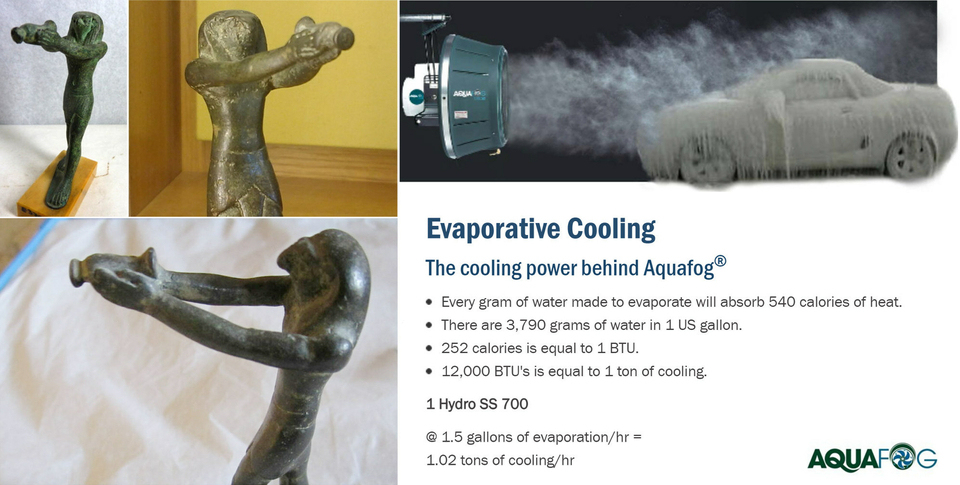
The ancient Egyptian god Horus, holding the fog nozzle that created the fog of microdroplets inside the evaporative cooling passage of the Great Pyramid of Giza.
Horus images : E3752 from the Louvre Museum and figurine of Horus DUT162 also from the Louvre Museum ; Paris, France. Date de creation et fabrication: Basse Epoque (664 - 332 BCE).
Evaporative cooling applications webpage screenshot : AquaFog® from Jaybird Manufacturing Inc (USA).
45.17 Imhotep's "stone vases" are probably an allusion to the fog nozzle of the evaporative cooling passage because of Djoser's Step Pyramid that was called the "Refreshment of the Gods"
“The Chancellor of the King of Lower Egypt, administrator of the Grand Palace, hereditary nobleman, High Priest of Heliopolis, Imhotep, the builder, the sculptor, the maker of stone vases.” https://www.wonders-of-the-world.net/Pyramids-of-Egypt/Imhotep.php
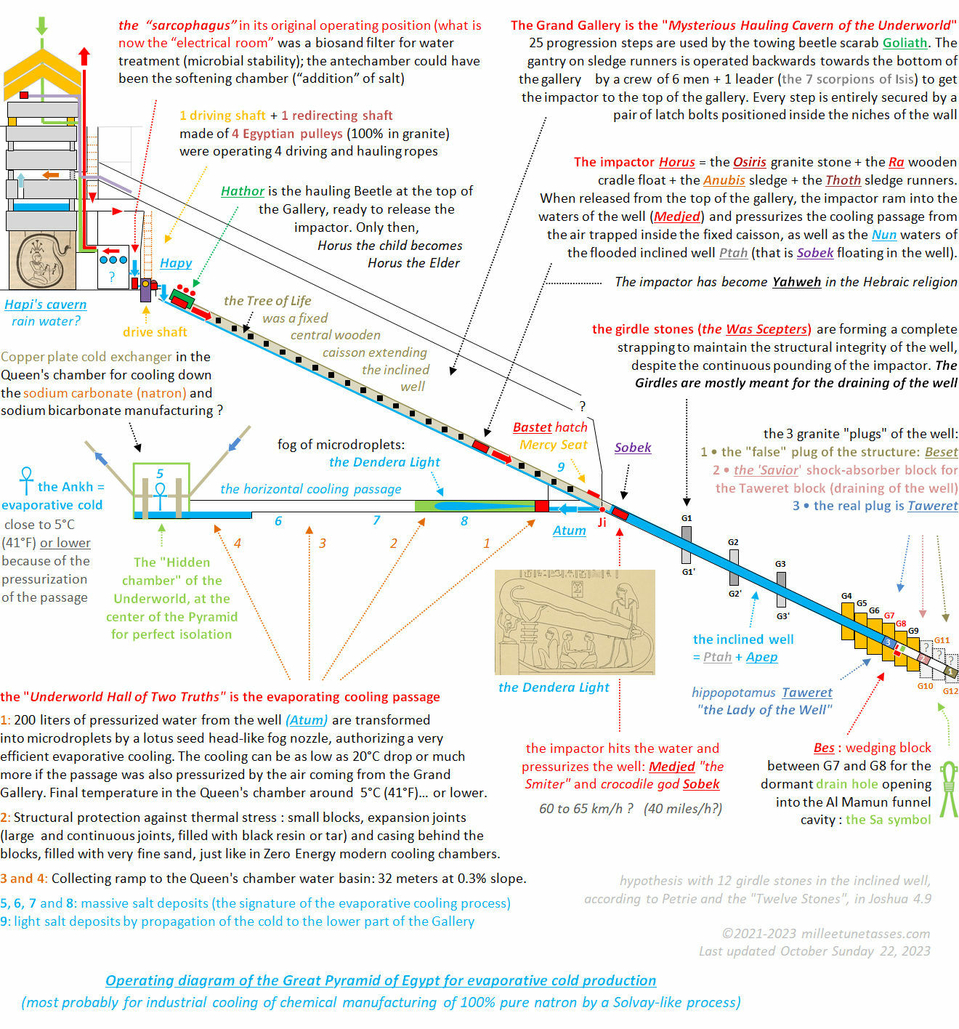
Even if highly probable, the hypothesis that the evaporative cold has been created for the cooling of Solvay-like chemical reactions for the manufacturing of sodium carbonate (the ancient Egyptian “natron” used for the mummification of the pharaohs), is still a simple hypothesis based on the Disc of Sabu and the limestone kiln + huge ammonia smell of the Red Pyramid).
45.18 Operation of the Great Pyramid of Giza for flash evaporation cooling
If Imhotep certainly didn’t built the Great Pyramid of Giza, he is certainly the one who designed its entire internal layout which served for the creation of evaporative cold by flash evaporation of liquid water in the horizontal passage. The massive salt deposits which were discovered in the Pyramid where indeed only located in this particular passage and chamber. The Queen’s chamber being the storage chamber of the cold, it explains why it is the only one located on the central axis of the Pyramid. In other words: the entire layout has been designed so that the Queen’s chamber was indeed in the center of the Pyramid, and only for a thermal insulation reason.
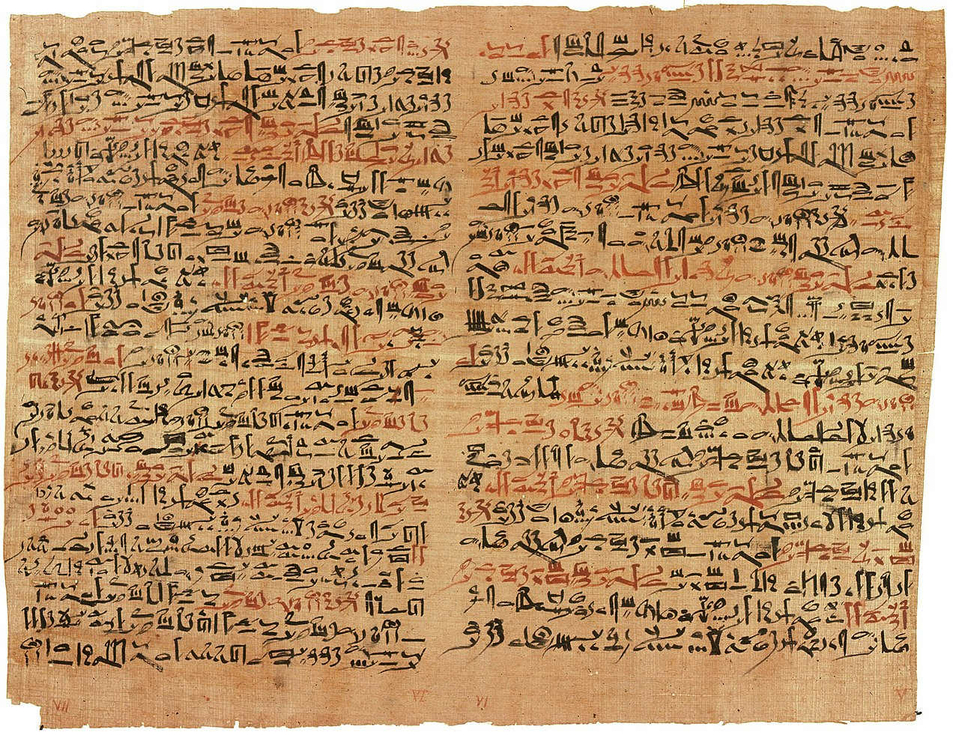
“The Edwin Smith papyrus, the world's oldest surviving surgical document. Written in hieratic script in ancient Egypt around 1600 B.C., the text describes anatomical observations and the examination, diagnosis, treatment, and prognosis of 48 types of medical problems in exquisite detail. Among the treatments described are closing wounds with sutures, preventing and curing infection with honey and moldy bread, stopping bleeding with raw meat, and immobilization of head and spinal cord injuries. Translated in 1930, the document reveals the sophistication and practicality of ancient Egyptian medicine. Recto Column 6 (right) and 7 (left) of the papyrus, pictured here, discuss facial trauma. (Cases 12-20).”
"Authorship of the Edwin Smith Papyrus is debated. The majority of the papyrus was written by one scribe, with only small sections copied by a second scribe. The papyrus ends abruptly in the middle of a line, without any inclusion of an author. It is believed that the papyrus is an incomplete copy of an older reference manuscript from the Old Kingdom, evidenced by archaic grammar, terminology, form and commentary. James Henry Breasted speculates - but emphasises that this is pure conjecture based on no evidence - that the original author might be Imhotep, an architect, high priest, and physician of the Old Kingdom, 3000–2500 BCE." https://en.wikipedia.org/wiki/Edwin_Smith_Papyrus

45.19 Without the extended knowledge of Imhotep in anatomy, physiology and medicine there wouldn't be any possible metaphor in these particular fields
Just like Leonardo da Vinci had many painters working for him, Imhotep would have had hundreds of people working for him in all fields of knowledge like engineering, physics, chemistry, mathematics, biology, medicine and of course in literature: it has to be Imhotep who supervised the elaboration of the entire design of the Great Pyramid, and it has to be Imhotep who initiated the elaboration of the entire glorification process, otherwise there couldn’t have been so many anatomical and medical metaphors.
In short, Imhotep designed everything, but was certainly dead when the construction of the Great Pyramid really began.
Of course, this is the reason why Imhotep has been one of the very few non-royal person to be ever deified and worshiped in ancient Egypt: he was the real Mastermind behind all the magic that happened in the Great Pyramid.
Example: the role of the kidneys (the filtering organs of the human body) in Section 27 "The Guide to the Afterlife"

Cover of the first volume of Maus, by Itzhak Avraham ben Zeev "Art" Spiegelman: wikipedia.org/wiki/Maus
“Why does racist imagery often show people of certain backgrounds as animals? Rats make us think of disease, dirt and infestation, and have been used to represent Jews in anti-Semitic imagery throughout history into the present. Take a look at this is propaganda poster from the 1940s when the Nazis occupied Denmark. The text reads “Rats. Destroy them.” In a Nazi propaganda film, the Eternal Jew the occupants of a Jewish ghetto are shown in tight quarters likened to rats swarming in a sewer. The statement “Destroy them” is particularly vile due to the common use of Zyklon B to eradicate rats as well as its use in the Nazi death camp’s gas chambers.” Horwitz-Wasserman Holocaust Memorial Plaza, Philadelphia (USA).
45.20 Why does racist imagery often show rats used to represent Jews throughout history into the present
If there is one thing to keep in mind from the Sections 40, 41, 42 and 43 about the reinterpretation of the operation of the Great Pyramid, it is the fact that the Jewish religion is only about the operation of the Grand Gallery and that what is called “Jewish” people in the Bible is only referring to the 7 crewmembers of the hauling Beetle (6 inside the Beetle, including "David", and the leader "Saul" on the top platform).
It is not about 7 people, but about all the people who assumed a position among these crewmembers. That is the origin of what have been called the Jewish people and it explains why rats have been used thoughout history to represent Jews.
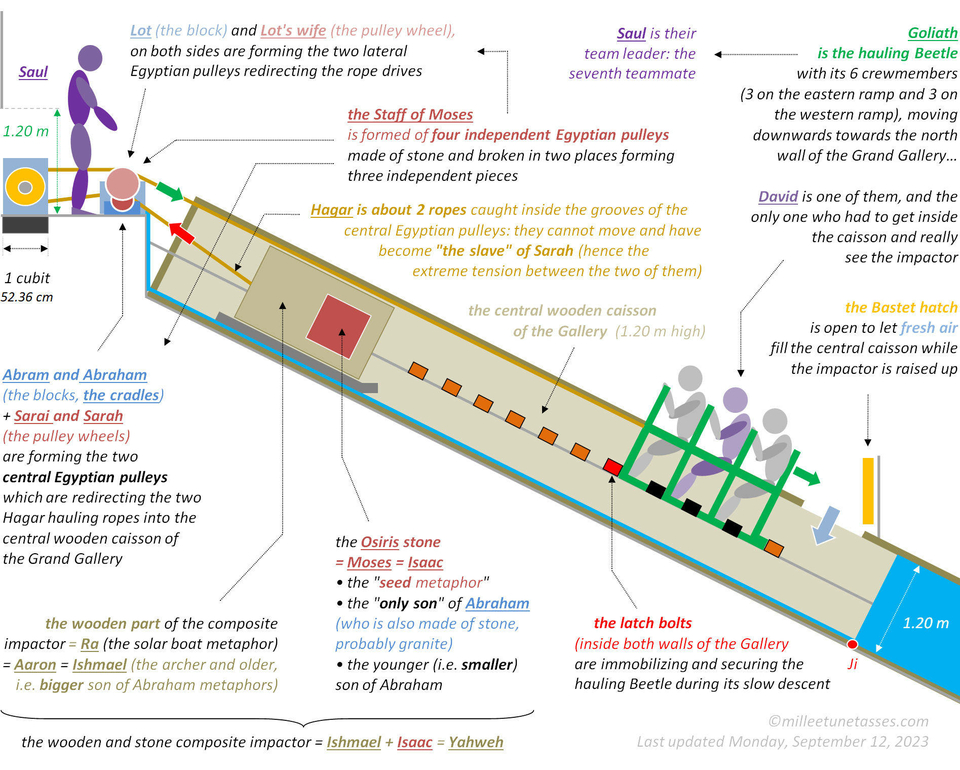
The Grand Gallery's basic operation inside the Great Pyramid of Egypt and showing the two Staffs of Aaron and Moses: respectively a driving shaft and a guiding shaft. In many ways, the impactor was more or less operated just like the anchor on a modern ship. Last updated September 12, 2023.

Tunel de Cudillero, by Jose Manuel mazintosh: flickr.com/photos/mazintosh/3888844783/in/photostream/
Original image of the Grand Gallery of the Great Pyramid of Egypt at Giza, built by pharaoh Khufu, from page 52 of "The call of the stars; a popular introduction to a knowledge of the starry skies with their romance and legend" (1919) by Kippax, John R. (John Robert), 1849-1922: https://www.flickr.com/photos/internetarchivebookimages/14597229618/
45.21 The Grand Gallery would have looked like a perfect sewer... with "rats" on both ramps
When you know who really are Jews, so to speak; when you know what is their real origin and when you know that they are all about these guys working their ass off onto the two lateral ramps of the Grand Gallery, apart from what would have looked exactly like a sewer, then you understand the rat metaphor: caught inside their own individual “niches”, or “cells”, the 6 crewmembers of the Beetle would have looked like rats caught inside their little individual cages or traps.
45.22 Rats live in sewers and are literally known to “carry” diseases
I personally think the rat metaphor goes even farther, because it is well known that rats are only carrying diseases… just like they were carrying the impactor all day long.
“Rats, like many other species, can be hosts to a number of diseases, and are known natural reservoirs of several zoonoses (infectious diseases able to be transmitted between species). Both Black rats and Brown rats are well known rodents that have had a close relationship with humans since the beginnings of civilization. They can also carry parasites like rat lungworm.” https://en.wikipedia.org/wiki/Category:Rodent-carried_diseases
The Ultimate Rat Trapping System, by Shawn Woods: youtube.com/watch?app=desktop&v=LrgiTI3pC7M

45.23 The crewmembers of the hauling Beetle would have looked like rats caught in their individual cages
We’ve already seen in these Sections a few metaphors that have been used in Jewish religion to describe these crewmembers. We’ve seen David and Goliath (Goliath being the Beetle and David the one who had to physically get in the central wooden caisson to reattach the impactor with the 2 hauling ropes), the 5 little stones of David, and there is another one: the metaphoric use of rats.
Ironically, this is a metaphor which has always been seen as extremely pejorative and insulting for Jews, but when you know its real meaning I only hope at least some people will one day either stop using it, either stop feeling insulted by it.
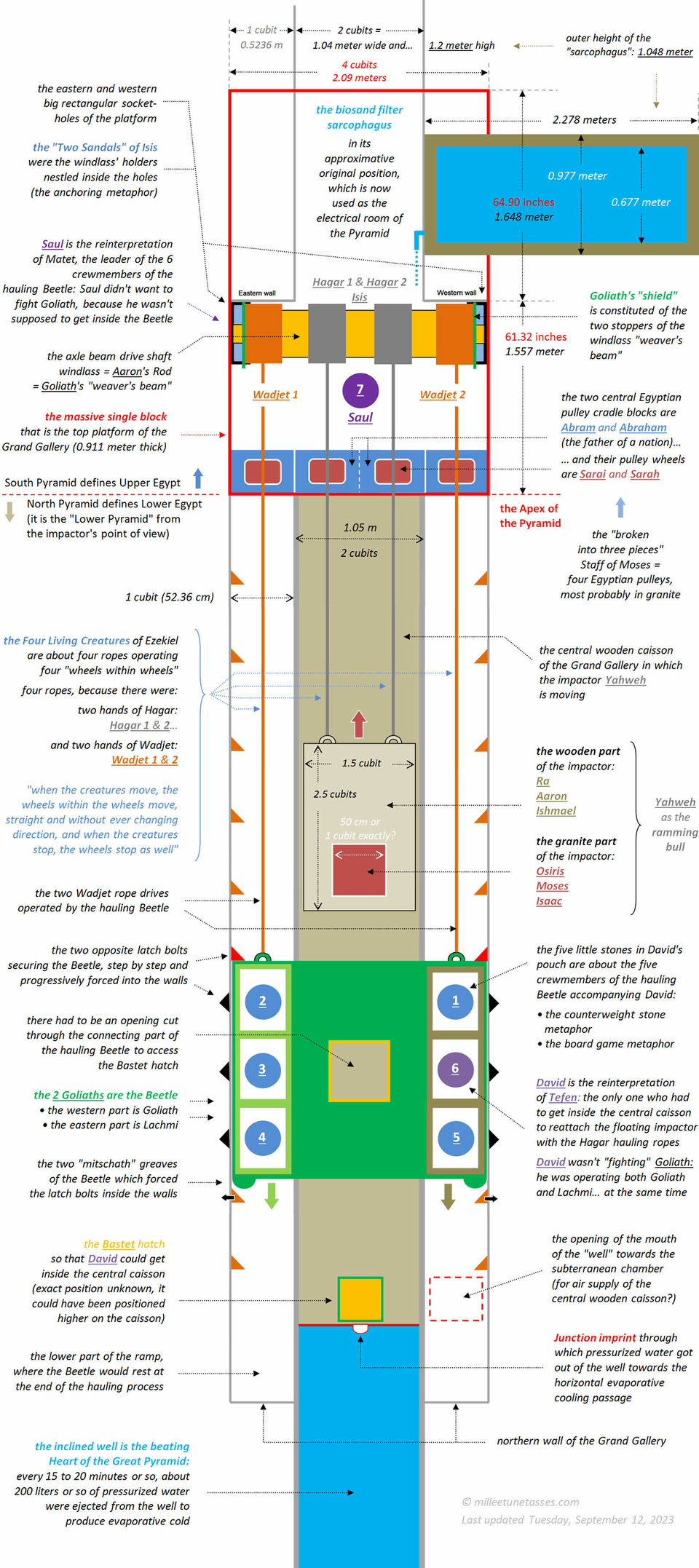
The Grand Gallery's basic operation inside the Great Pyramid of Egypt and showing the two Staffs of Aaron and Moses: respectively a driving shaft and a guiding shaft. In many ways, the impactor was more or less operated just like the anchor on a modern ship. Last updated September 12, 2023.
45.24 Operation of the Grand Gallery of the Great Pyramid for pressurized air and pressurized water production
Caught in the hauling Beetle, the crewmembers would have looked like stones on a game board (the five little stones of David fighting Goliath)… or rats, prisoners of their individual “cages”, or “traps”.
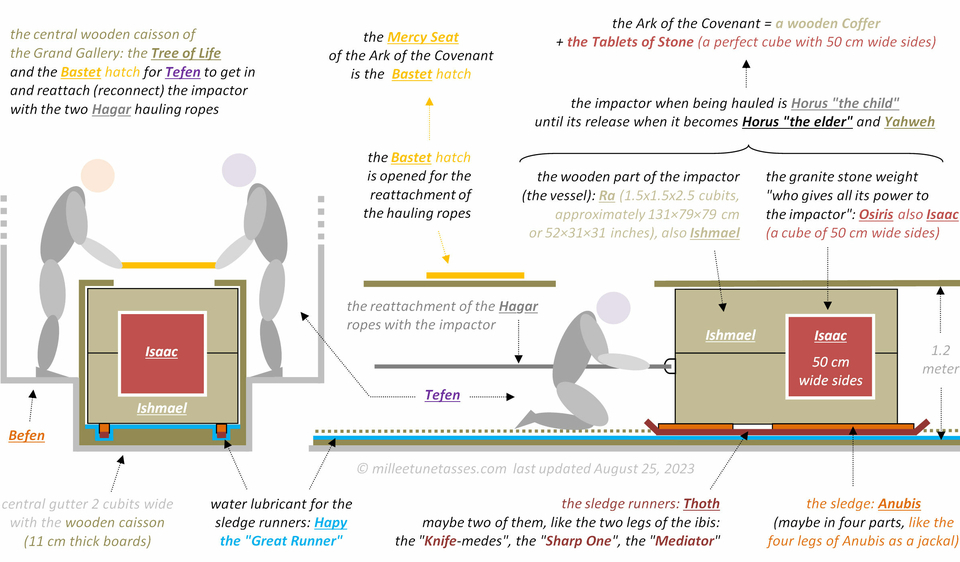
The reattachment of the impactor with the two central hauling ropes, by David (the reinterpretation of Tefen).
45.25 David, opening the "cover" Bastet hatch of the central caisson and literally getting into the "sewer"
It is "sad" somehow to realize that this "rat metaphor" is actually so perfect, when you really think it through.
The Pyramids of the Cold version 2 (May 2023 - May 2024)
Summary of the study and Table of Contents
Part A: The evaporative cooling process
Section 1 • The horizontal evaporative cooling passage layout
Section 2 • The Dendera Light and the creation of the fog of microdroplets by the fog nozzle
Section 3 • The water cycle glorifying metaphors: Geb, Shu, Nut, Tefnut
Section 4 • The theorization of the evaporative cooling process by Akhenaten and Nefertiti
Section 5 • The theorization of the evaporative cooling process in the Weighing of the Heart
Part B • The inclined well of the Great Pyramid of Giza
Section 6 • The inclined well layout and the girdle stones
Section 7 • The Taweret "Lady of the Well" temporary sealing granite plug of the well
Section 8 • The Bes temporary wedging block immobilizing Taweret
Section 9 • The draining of the well
Section 10 • The Great Serpent Apep and the snake water metaphors
Section 11 • The Was scepter and the control over "snakes"
Section 12 • The beating Heart of the Great Pyramid
Part C • The composite impactor of the Great Pyramid (Horus, Ra, Osiris, Medjed, Sobek...)
Section 13 • The wooden and stone composite design of the impactor: Ra and Osiris
Section 14 • The endlessly immersed Osiris stone and the seed metaphor
Section 15 • The Anubis sledge and the bobsled mask
Section 16 • The sledge runners of the impactor: Thoth
Section 17 • Medjed: the smiter nobody can ever see
Section 18 • The Apis bull and the ramming impactor's metaphors
Section 19 • The crocodile god Sobek impactor (more or less) floating in the waters of the well
Section 20 • The Obelisk and the Benben stone rising from water
Part D • The Grand Gallery's of the Great Pyramid of Giza
Section 21 • The Sacred "sloping paths" of the "oval-shaped cavern of the act of Hauling"
Section 22 • The central wooden caisson of the Gallery: Sekhmet and the Triad of Memphis
Section 23 • The hauling ropes of the Grand Gallery: Isis, Nephthys, Hatmehit, Wadjet and Nekhbet
Section 24 • The hauling Beetle and the Seven Scorpions of Isis
Section 25 • The Great Cow goddess Hathor and the operating cycle of the hauling Beetle
Section 26 • The 10 operating phases of the Grand Gallery
Section 27 • The guide to the Afterlife for the smart traveler and the canopic jars
Section 28 • The scarab amulet glorifications of the hauling Beetle
Part E • The very large and roughly finished sarcophagus of the Great Pyramid
Section 29 • The biosand filter sarcophagus of the Great Pyramid
Section 30 • The Elephantine Triad deification of the biosand filter of the Great Pyramid
Section 31 • The Great Pyramid's operating flat roof and the water supply issue
Part F • Chemical manufacturing and industrial cooling before the Great Pyramid
Section 32 • The Serdab and the "Refreshment of the Gods" Step Pyramid of Djoser
Section 33 • Sneferu's Red Pyramid and the accumulated ammonia
Section 34 • The Disc of Sabu and the Solvay process for pure natron manufacturing
Part G • The tremendous impact of the Great Pyramid on the whole ancient world
Section 35 • The hidden secrets of the Hermetica Emerald Tablet (around 1600 C.E.)
Section 36 • Thor and the magical Hammer in the Great Hall of Bilskirnir
Section 37 • The Churning of the waters of the Ocean of Milk (Hindu mythology)
Section 38 • The Tibetan prayer wheels and the Grand Gallery's operation
Section 39 and Conclusion • The cooling water of spitting Kebechet
Part H • Epilogue
Section 40 • The smiting Ark of the Covenant and the Ten Commandments
Section 41 • The 293 kilograms windlass Staff of Moses and Aaron... and the First Plague of Egypt: water turning into blood
Section 42 • Ezekiel's Four Egyptian pulley "Wheels within the Wheels" and the four angel ropes
Section 43 • David, Saul, two giant Goliaths, five little stones, an aeolian harp... and a weaver's beam
Section 44 • The holy water fonts and the biosand filter
Part I • The magicians of the Great Pyramid of Giza
Section 45 • The Legend of Khufu and the "magician" polymath Imhotep
Section 46 • The two magical eyes of Isis and the brilliant but painful flame of her twin sister's braids
Section 47 • The Aegis Shield of Athena "Subduer of the Winds" and the upper hatch of the central wooden caisson
Section 48 • The Seven Magical Words spoken by 'Divine Sealer' Goddess of Arrows and Bronze Neith
Poster un commentaire

